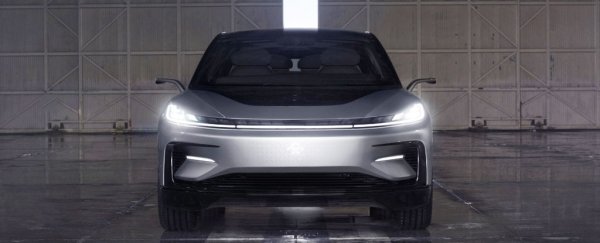After years of anticipation, the mysterious electric vehicle (EV) startup Faraday Future has finally unveiled its first production model, the FF 91.
The company, which is based in the US but financed by Chinese consumer electronics giant LeEco, showed off a prototype of its first actual car at CES in Las Vegas on Tuesday after years of only teasing glimpses of its auto technology – and if the FF 91 can do everything Faraday Future says it can, Tesla could have a formidable EV competitor.
The FF 91 looks to be something of a futuristic hybrid, somewhere between a sedan and an SUV, but offering the interior of a luxury vehicle and the performance of a high-end sports car.
The vehicle, which can be reserved for a "fully refundable" $5,000 deposit, is expected to enter production in 2018, and offers an electric motor capable of 783 kW, equivalent to a 1,050-horsepower engine.
 Faraday Future
Faraday Future
That grunt helps the FF 91 get from 0 to 60 miles per hour (96.6 km/h) in just 2.39 seconds, which Faraday Future says makes it the world's fastest-accelerating car – beating the Tesla Model S P100D, which takes 2.5 seconds.
Aside from raw speed, the company also says the car is packed with a record-breaking 130 kWh battery, capable of lasting for 482 miles (775 kilometres) when driven at a speed of 55 mph (88.5 km/h).
The battery itself is capable of recharging more than 500 miles every hour (804.6 km), but the home charger kit the car comes with will make things slower, achieving a 50 percent recharge in about 4.5 hours at 240V.
Faraday Future is packing the vehicle with a huge number of technological features designed to adapt to the driver, such as cameras that unlock the car when your face is recognised – and interior settings such as seating positions and light levels to match user preferences.
In terms of assisted driving, the FF 91 offers what Faraday Future calls a "Driverless Valet" parking feature, which lets you exit the vehicle and watch as the car finds and parks itself in an available space – plus pick you up later from a designated spot at a particular time.
Showing this feature off at the CES unveiling, the company only had mixed success though. In a demonstration filmed in a public parking lot, the car drove itself into an empty space, but in a separate on-stage demo, the vehicle failed to move when prompted, causing Faraday Future SVP of engineering to awkwardly joke "Okay, it seems like it's a little bit… lazy tonight."
Sampson later explained the malfunction was due to the unusual dimensions of the stage area, blaming the steel structures above the car for interfering with the car's signals.
 Faraday Future
Faraday Future
But far more significant than any live demo jitters are the concerns over the stability of Faraday Future itself.
While the specifications and finishes make the FF 91 look very compelling, there are widespread doubts over whether Faraday Future can actually deliver the vehicle to market like it promises.
The company was beset by a string of ongoing controversies throughout 2016, including the departure of several key executives and allegations that the company was embroiled in a financial meltdown.
Most damning of all however, was the revelation in November that construction on the company's massive factory in Nevada – presumably where the FF 91 would be built – was on hold over missed payments.
At CES, Faraday Future was defiant but did not address the issues directly, with Sampson merely stating, "Despite all the naysayers and the skeptics we will persist".
But while the spirit on show is admirable, it's not sure if persistence will be enough.
Automotive analyst Mike Ramsay from Gartner wasn't necessarily convinced by the company's FF 91 unveiling, pointing out that the 130kW battery pack would make the car extremely heavy, and be very expensive.
"This is a must impress situation," he told Chris Baraniuk at BBC News. "Even if everything had been going perfectly, it is very difficult to be a start-up carmaker, particularly when you are coming from a tech background… [The FF 91] still seems like it's more in the realm of fantasy than reality."
We hope not, because the car looks pretty amazing to us in terms of the prototype (despite the parking malfunction).
And if it can actually be delivered, greater competition in the EV market will force Tesla and other car manufacturers to deliver better, more affordable electric vehicles – which is something the world needs right now.
Alas, if Faraday Future does produce the FF 91, it definitely won't come cheap. Early estimates put a likely price at US$180,000 or more, so you might want to start saving up now.
